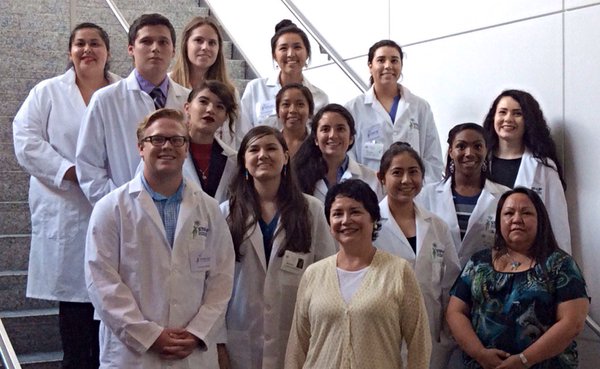
Historically underrepresented populations are the largest “untapped STEM talent pools in the United States.”…“Given the shifting demographic landscape, the United States should encourage full participation of individuals from underrepresented populations in STEM fields.” – Public Law 114-329, American Innovation and Competitiveness Act of 2017. Public Law 114-225, 21st Century Cures Act of 2016 requires the NIH Director to “[d]evelop, modify, or prioritize policies, as needed to … increase opportunities for new researchers to receive funding, enhance training and mentorship programs for researchers, and enhance workforce diversity.”
“There is a national need for minority scientists in the fields of biomedical, clinical, behavioral, and health services research.”-- Public Law 106-525, Minority Health and Health Disparities Research and Education Act of 2000. The National Science Foundation reports that African Americans (or Blacks), American Indians and Alaska Natives, Hispanics (or Latinos), Native Hawaiians and other Pacific Islanders are underrepresented at many career stages in health-related sciences on a national basis. (See the report Women, Minorities, and Persons with Disabilities in Science and Engineering, National Science Foundation, 2019). Individuals from these groups are under-represented when compared to their age-cohorts in science-baccalaureate earners, among science-PhD earners, and in the biomedical workforce overall.
In 2015, only 7 percent of science and engineering doctorate holders employed as full-time, full professors at all institutions were from underrepresented racial and ethnic groups, and at Research Intensive institutions, this proportion falls to only four percent. Moreover, among science and engineering doctorate holders with full-time faculty employment at any four-year institution, those from underrepresented racial and ethnic groups were less likely to receive federal grants or contracts than their white counterparts (See the report Women, Minorities, and Persons with Disabilities in Science and Engineering, National Science Foundation, 2019).
Underrepresentation is also apparent among physicians and physician-scientists in the biomedical workforce. The Association of American Medical Colleges (AAMC) reports that nationally underrepresented racial and ethnic groups comprise about nine percent of the US physician workforce; this poses important concerns for effective health care delivery. Among those with a medical degree, only about two percent report a career in research, and among MDs (or MD-PhDs) with NIH research grants, about seven percent were awarded to individuals from these underrepresented racial and ethnic groups.
Data on overall participation of individuals from underrepresented racial and ethnic groups in biotechnology, contract research organizations and pharmaceutical industry career sectors is not readily available. Job growth in these areas is strong, and several companies report a workforce with significant diversity, although there may be little diversity at the higher echelons of pharmaceutical firms (see the National Diversity Council’s “Leading While Diverse” report, below).
The following racial and ethnic groups have been shown by the National Science Foundation to be underrepresented in health-related sciences on a national basis: Blacks or African Americans, Hispanics or Latinos, American Indians or Alaska Natives, Native Hawaiians and other Pacific Islanders. See data at http://www.nsf.gov/statistics/showpub.cfm?TopID=2&SubID=27) and the reportWomen, Minorities, and Persons with Disabilities in Science and Engineering).
In addition, it is recognized that underrepresentation can vary from setting to setting; individuals from racial or ethnic groups that can be demonstrated convincingly to be underrepresented by the grantee institution should be encouraged to participate in NIH programs to enhance diversity. For more information on racial and ethnic categories and definitions, see the OMB Revisions to the Standards for Classification of Federal Data on Race and Ethnicity.
- Women, Minorities and Persons with Disabilities in Science and Engineering, National Science Foundation (2019)
- Report on Progress of Activities of the NIH Advisory Committee to the Director Working Group on Diversity (2017)
- Leading While Diverse, Report from National Diversity Council (2016)

- Colloquy on Minority Males in Science, Technology, Engineering, and Mathematics, Report from The National Academies of Sciences, Engineering, and Medicine (2012)

- Draft Report of the NIH Advisory Committee to the Director Working Group on Diversity in the Biomedical Research Workforce (2012)
- Race, Ethnicity, and NIH Research Awards. Science 6045:1015-1019 (2011)
- Weaving a Richer Tapestry in Biomedical Science. Science 6045:940-941 (2011)
- Expanding Underrepresented Minority participation: Americas Science and Technology Talent at the Cross Roads, Report from The National Academies of Sciences, Engineering, and Medicine (2011)

- The Road to the STEM Professoriate for Underrepresented Minorities: A Review of the Literature, American Institutes for Research (2009)

- Ph.D. Completion and Attrition: Analysis of Baseline Demographic Data from the Ph.D. Completion Project, Council of Graduate Schools (2008)

- Making the Difference: Applying a Logic of Diversity. Academy of Management 21:6-20 (2007)

- What Matters to Student Success: A Review of the Literature, Report from National Postsecondary Education Cooperative (2006)





